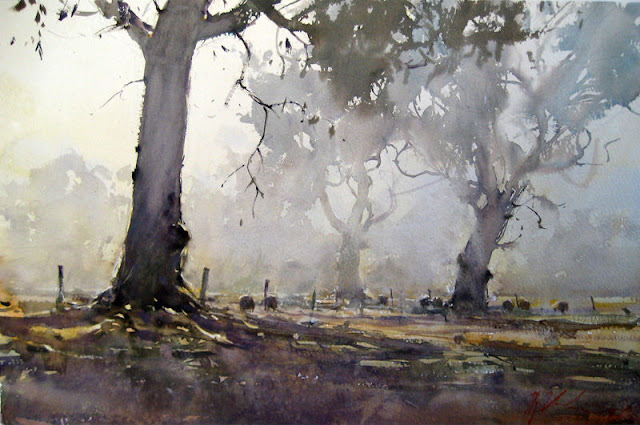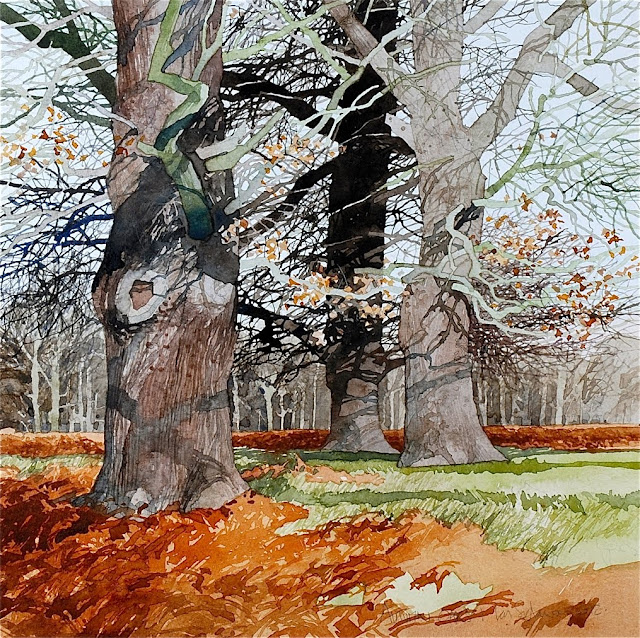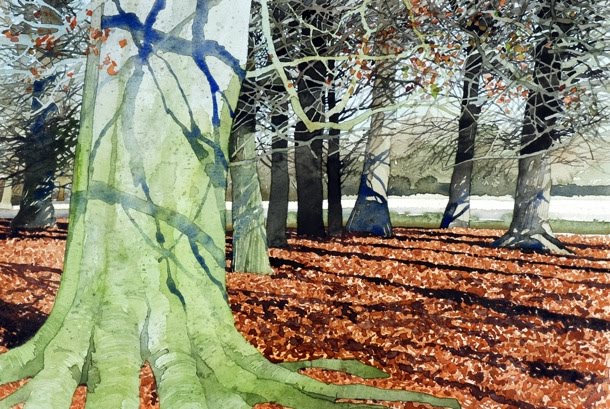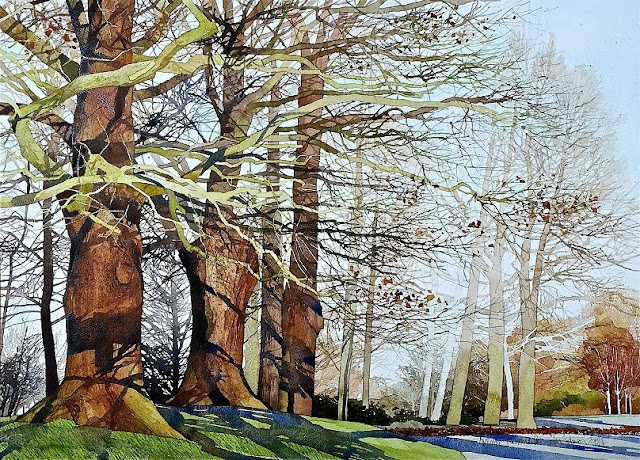We begin this term by exploring composition in landscape, as some of us go out and paint on location and I thought it would be useful to address questions of what do I paint, how do I paint it, and how much can I paint in the time we have allocated.
We are continuing to tackle application in watercolour but with the aforementioned as a theme to work with.
First we looked at some simple armatures, = ( these are the structures that hold a composition together )
for example the group of trees top left is an example of a fulcrum armature, fulcrum meaning weighing scales, note that the group of trees on the right hand side are larger, and have more visual pulling power than the smaller tree on the left, the smaller tree is present to counter balance the pulling weight of the big clump of trees, without it the composition would be weighted too much on the right, but a clump of trees on the left of equal size would create a static and prosaic painting, it is thought amongst artists that this imbalance of weight creates dynamism and interest in a painting, we will be moving on to the is theme in week 2.
This is from a book called mastering composition by Ian Roberts, and it is my composition bible : )
All this was to outline where this summer term is headed, but today, we started by exploring different ways of representing trees, as we need to know how to paint trees if we are going to paint landscapes.
Here are 3 paintings by David Curtis, note that he only has high definition in certain areas, everything else is loosely described with a beautiful mix of colours and suggestion, a form of visual poetry rather than visual prose, these are not botanical paintings of trees
This painting below by Joseph Zbukvic has a similar way of suggesting trees but this is even more minimal, allowing the detail and contrast of this group of painters to be the lead singer, and the background to be the backing group, this kind of simplification is called value massing, that means tying a multitude of complex visual information together in 1 mass of colour and tone.
The 2 paintings below that are characterised again by the lack of detail on the foliage by painting them either wet in wet or by dry brushstroke
this painting below also owes it's etherial quality to the lack of detail and it's focus on light and minimal suggestion, it is stunningly beautiful and evocative of a gentle stillness.

These next paintings in my opinion is equally beautiful, by Ian sideaway, there is a great deal of detail and realistic representation here and beautifully observed, but it is unlikely that we would be able to achieve this amount of detail by a short outdoor painting trip, called painting 'en plain air' I love these painting for their strong abstract shapes which he achieves by using strong sunlight, a limited pallet and knowing where to crop the painting / view





So we have to decide what we can achieve in a short space of time for our ability level, and we settle on a simple dry brushstroke grew by Ron Ranson, the reason I chose this was because in simplifying the value mass of foliage it makes it very quick to paint, but because the edges are broken up are suggestive of foliage.
We began by practicing 'dry' brushstroke on rough watercolour paper, I used st cuthberts mill Bockingford 300gm rough wc paper.
Using dry brush stroke doesn't literally mean dry, but we use a dryer brush than normal, coat the whole length of the brush with pigment, and apply this to the paper at an extremely shallow angle, so much so, the metal part is almost touching the paper, where this went wrong, was using too much water, too steep an angle and pressing down too hard or dabbing, the brush needs to be smoothed over the paper, so that you are almost tickling it, the idea being, that your brush only comes into contact with the rough surface of the paper, leaving the textured lower parts untouched.
However, if you see in the example above, we filled in the centre of the foliage washes by pressing harder, and broke the edges up with a much lighter touch.
A quick tree for field work
 |
| The photographic reference we used |
The trees below are my demonstrations, we used lemon yellow and indigo to keep these washes as uncomplicated as possible whilst we got to grips with the dry brushstroke technique
For my own simple tree paintings I use a variety of colours and textures once I have established the areas of value mass, see above
For my own simple tree paintings I use a variety of colours and textures once I have established the areas of value mass, see above

Next week we will be practicing the same technique, but we will begin to get to grips with the fulcrum armature of composition.













No comments:
Post a Comment